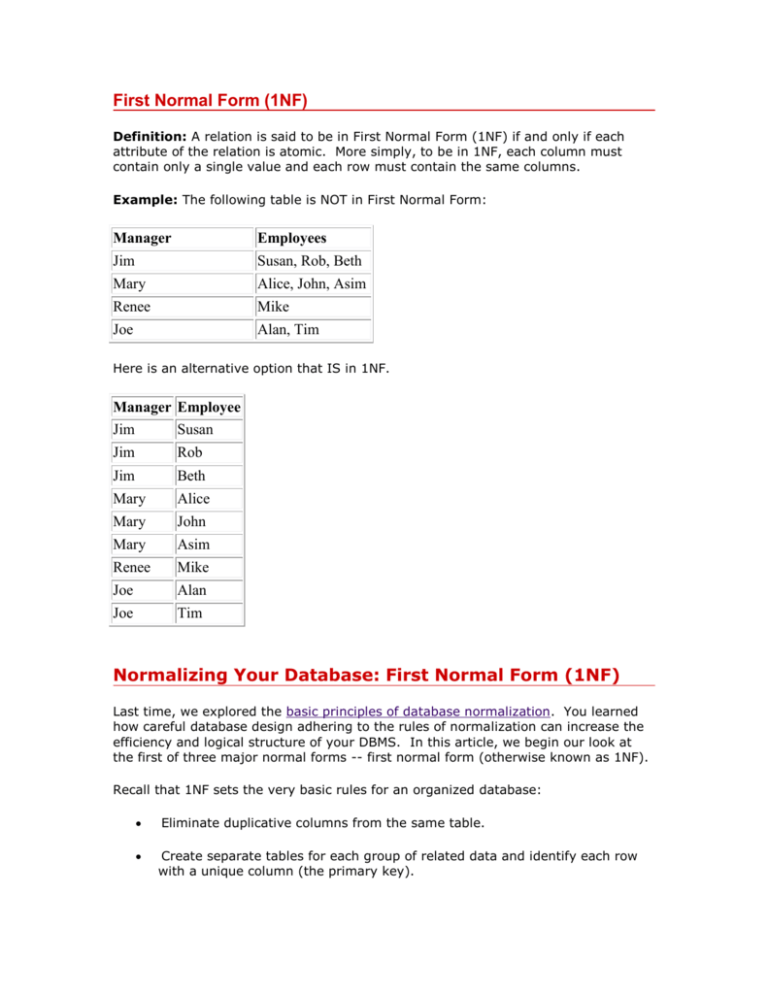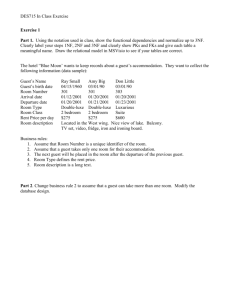First Normal Form (1NF)
advertisement

First Normal Form (1NF) Definition: A relation is said to be in First Normal Form (1NF) if and only if each attribute of the relation is atomic. More simply, to be in 1NF, each column must contain only a single value and each row must contain the same columns. Example: The following table is NOT in First Normal Form: Manager Jim Employees Susan, Rob, Beth Mary Alice, John, Asim Renee Mike Joe Alan, Tim Here is an alternative option that IS in 1NF. Manager Employee Jim Susan Jim Rob Jim Beth Mary Alice Mary John Mary Asim Renee Mike Joe Alan Joe Tim Normalizing Your Database: First Normal Form (1NF) Last time, we explored the basic principles of database normalization. You learned how careful database design adhering to the rules of normalization can increase the efficiency and logical structure of your DBMS. In this article, we begin our look at the first of three major normal forms -- first normal form (otherwise known as 1NF). Recall that 1NF sets the very basic rules for an organized database: Eliminate duplicative columns from the same table. Create separate tables for each group of related data and identify each row with a unique column (the primary key). What do these rules mean when contemplating the practical design of a database? It’s actually quite simple. The first rule dictates that we must not duplicate data within the same row of a table. Within the database community, this concept is referred to as the atomicity of a table. Tables that comply with this rule are said to be atomic. Let’s explore this principle with a classic example – a table within a human resources database that stores the manager-subordinate relationship. For the purposes of our example, we’ll impose the business rule that each manager may have one or more subordinates while each subordinate may have only one manager. Intuitively, when creating a list or spreadsheet to track this information, we would draw up something like this: Manager Bob Mary Jim Subordinate1 Jim Mike Alan Subordinate2 Mary Jason Subordinate3 Beth Carol Subordinate4 Mark However, recall the first rule imposed by 1NF: eliminate duplicative columns from the same table. Clearly, the Subordinate1-Subordinate4 columns are duplicative. Take a moment and ponder the problems raised by this scenario. Jim only has one subordinate – the Subordinate2-Subordinate4 columns are simply wasted storage space (a precious database commodity). Furthermore, Mary already has 4 subordinates – what happens if she takes on another employee? The whole table structure would require modification. At this point, a second bright idea usually occurs to database novices: We don’t want to have more than one column and we want to allow for a flexible amount of data storage. Let’s try something like this: Manager Bob Mary Jim Subordinates Jim, Mary, Beth Mike, Jason, Carol, Mark Alan This solution is closer, but it also falls short of the mark. The subordinates column is still duplicative and non-atomic. What happens when we need to add or remove a subordinate? We need to read and write the entire contents of the table. That’s not a big deal in this situation, but what if one manager had one hundred employees? Also, it complicates the process of selecting data from the database in future queries. Here’s a table that satisfies the first rule of 1NF: Manager Bob Bob Bob Mary Mary Subordinate Jim Mary Beth Mike Jason Mary Mary Jim Carol Mark Alan Now, what about the second rule: identify each row with a unique column or set of columns (the primary key)? You might take a look at the table above and suggest the use of the subordinate column as a primary key. In fact, the subordinate column is a good candidate for a primary key due to the fact that our business rules specified that each subordinate may have only one manager. However, the data that we’ve chosen to store in our table makes this a less than ideal solution. What happens if we hire another employee named Jim? How do we store his managersubordinate relationship in the database? It’s best to use a truly unique identifier (like an employee ID or SSN) as a primary key. Our final table would look like this: Manager 182 182 182 201 201 201 201 143 Subordinate 143 201 123 156 041 187 196 202 Now, our table is in first normal form! Join us next time as we explore the second normal form. Second Normal Form (2NF) Definition: In order to be in Second Normal Form, a relation must first fulfill the requirements to be in First Normal Form. Additionally, each nonkey attribute in the relation must be functionally dependent upon the primary key. Example: The following relation is in First Normal Form, but not Second Normal Form: Order # Customer Contact Person John Doe Total 1 Acme Widgets $134.23 2 ABC Corporation Fred Flintstone $521.24 3 Acme Widgets John Doe $1042.42 4 Acme Widgets John Doe $928.53 In the table above, the order number serves as the primary key. Notice that the customer and total amount are dependent upon the order number -- this data is specific to each order. However, the contact person is dependent upon the customer. An alternative way to accomplish this would be to create two tables: Customer Contact Person Acme Widgets John Doe ABC Corporation Fred Flintstone Order Customer # Total 1 Acme Widgets $134.23 2 ABC Corporation $521.24 3 Acme Widgets $1042.42 4 Acme Widgets $928.53 The creation of two separate tables eliminates the dependency problem experienced in the previous case. In the first table, contact person is dependent upon the primary key -- customer name. The second table only includes the information unique to each order. Someone interested in the contact person for each order could obtain this information by performing a JOIN operation. Normalizing Your Database: Second Normal Form (2NF) Over the past month, we've looked at several aspects of normalizing a database table. First, we discussed the basic principles of database normalization. Last time, we explored the basic requirements laid down by the first normal form (1NF). Now, let's continue our journey and cover the principles of second normal form (2NF). Recall the general requirements of 2NF: Remove subsets of data that apply to multiple rows of a table and place them in separate rows. Create relationships between these new tables and their predecessors through the use of foreign keys. These rules can be summarized in a simple statement: 2NF attempts to reduce the amount of redundant data in a table by extracting it, placing it in new table(s) and creating relationships between those tables. Let's look at an example. Imagine an online store that maintains customer information in a database. Their Customers table might look something like this: CustNum FirstName LastName Address 1 John Doe 2 Alan 3 City State ZIP 12 Main Street Sea Cliff NY 11579 Johnson 82 Evergreen Tr Sea Cliff NY 11579 Beth Thompson 1912 NE 1st St Miami FL 33157 4 Jacob Smith 142 Irish Way South Bend IN 46637 5 Sue Ryan 412 NE 1st St Miami FL 33157 A brief look at this table reveals a small amount of redundant data. We're storing the "Sea Cliff, NY 11579" and "Miami, FL 33157" entries twice each. Now, that might not seem like too much added storage in our simple example, but imagine the wasted space if we had thousands of rows in our table. Additionally, if the ZIP code for Sea Cliff were to change, we'd need to make that change in many places throughout the database. In a 2NF-compliant database structure, this redundant information is extracted and stored in a separate table. Our new table (let's call it ZIPs) might look like this: ZIP City State 11579 Sea Cliff NY 33157 Miami FL 46637 South Bend IN If we want to be super-efficient, we can even fill this table in advance -- the post office provides a directory of all valid ZIP codes and their city/state relationships. Surely, you've encountered a situation where this type of database was utilized. Someone taking an order might have asked you for your ZIP code first and then knew the city and state you were calling from. This type of arrangement reduces operator error and increases efficiency. Now that we've removed the duplicative data from the Customers table, we've satisfied the first rule of second normal form. We still need to use a foreign key to tie the two tables together. We'll use the ZIP code (the primary key from the ZIPs table) to create that relationship. Here's our new Customers table: CustNum FirstName LastName Address ZIP 1 John Doe 12 Main Street 11579 2 Alan Johnson 82 Evergreen Tr 11579 3 Beth Thompson 1912 NE 1st St 33157 4 Jacob Smith 142 Irish Way 46637 5 Sue Ryan 412 NE 1st St 33157 We've now minimized the amount of redundant information stored within the database and our structure is in second normal form! Third Normal Form (3NF) Definition: In order to be in Third Normal Form, a relation must first fulfill the requirements to be in Second Normal Form. Additionally, all attributes that are not dependent upon the primary key must be eliminated. Examples: The following table is NOT in Third Normal Form: Company City State ZIP Acme Widgets New York NY 10169 ABC Corporation Miami FL XYZ, Inc. Columbia MD 21046 33196 In this example, the city and state are dependent upon the ZIP code. To place this table in 3NF, two separate tables would be created -- one containing the company name and ZIP code and the other containing city, state, ZIP code pairings. This may seem overly complex for daily applications and indeed it may be. Database designers should always keep in mind the tradeoffs between higher level normal forms and the resource issues that complexity creates. Normalizing Your Database: Third Normal Form (3NF) Welcome to the fourth of five articles on database normalization! Over the past two months, we've explored the basic principles of database normalization as well as the specific requirements of first normal form (1NF) and second normal form (2NF). This week we'll look at third normal form, otherwise known as 3NF. In our first article, we looked at the basic requirements of 3NF. Here they are again to refresh your memory: Meet the requirements of 1NF and 2NF Remove columns that are not fully dependent upon the primary key. Imagine that we have a table of widget orders: Order Number Customer Number Unit Price Quantity Total 1 241 $10 2 $20 2 842 $9 20 $180 3 919 $19 1 $19 4 919 $12 10 $120 Remember, our first requirement is that the table must satisfy the requirements of 1NF and 2NF. Are there any duplicative columns? No. Do we have a primary key? Yes, the order number. Therefore, we satisfy the requirements of 1NF. Are there any subsets of data that apply to multiple rows? No, so we also satisfy the requirements of 2NF. Now, are all of the columns fully dependent upon the primary key? The customer number varies with the order number and it doesn't appear to depend upon any of the other fields. What about the unit price? This field could be dependent upon the customer number in a situation where we charged each customer a set price. However, looking at the data above, it appears we sometimes charge the same customer different prices. Therefore, the unit price is fully dependent upon the order number. The quantity of items also varies from order to order, so we're OK there. What about the total? It looks like we might be in trouble here. The total can be derived by multiplying the unit price by the quantity, therefore it's not fully dependent upon the primary key. We must remove it from the table to comply with the third normal form: Order Number Customer Number Unit Price Quantity 1 241 $10 2 2 842 $9 20 3 919 $19 1 4 919 $12 10 Now our table is in 3NF. But, you might ask, what about the total? This is a derived field and it's best not to store it in the database at all. We can simply compute it "on the fly" when performing database queries. For example, we might have previously used this query to retrieve order numbers and totals: SELECT OrderNumber, Total FROM WidgetOrders We can now use the following query: SELECT OrderNumber, UnitPrice * Quantity AS Total FROM WidgetOrders to achieve the same results without violating normalization rules.





